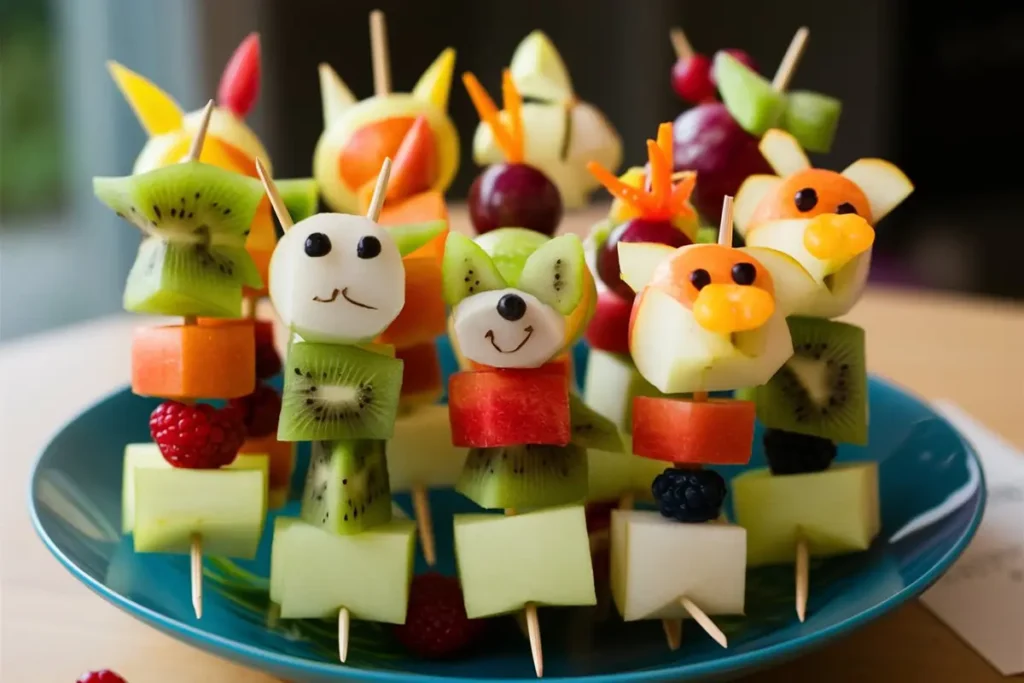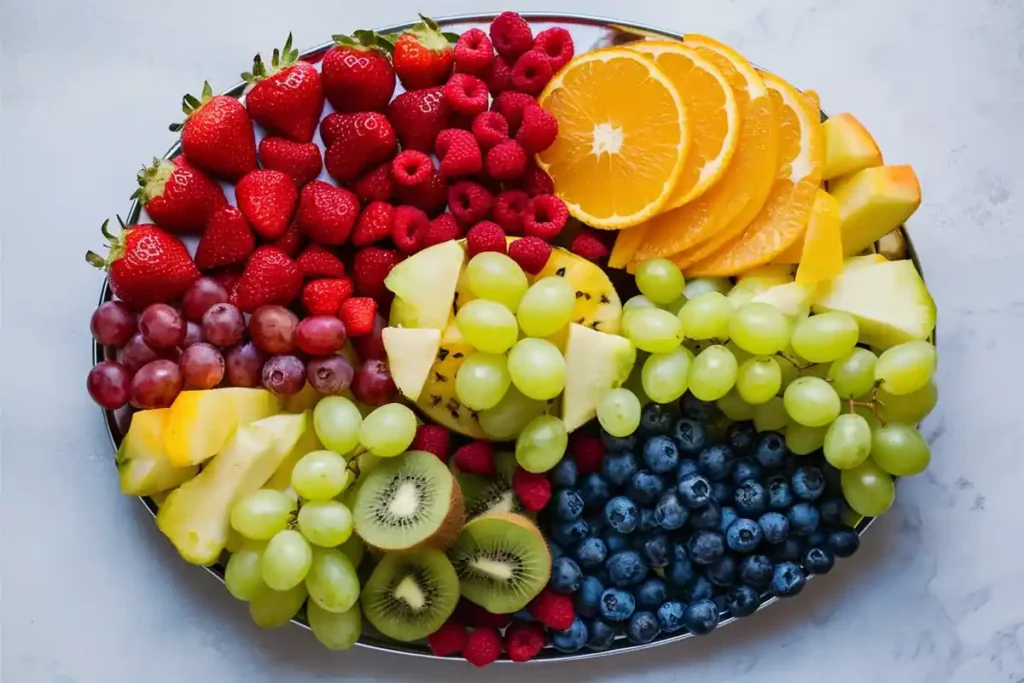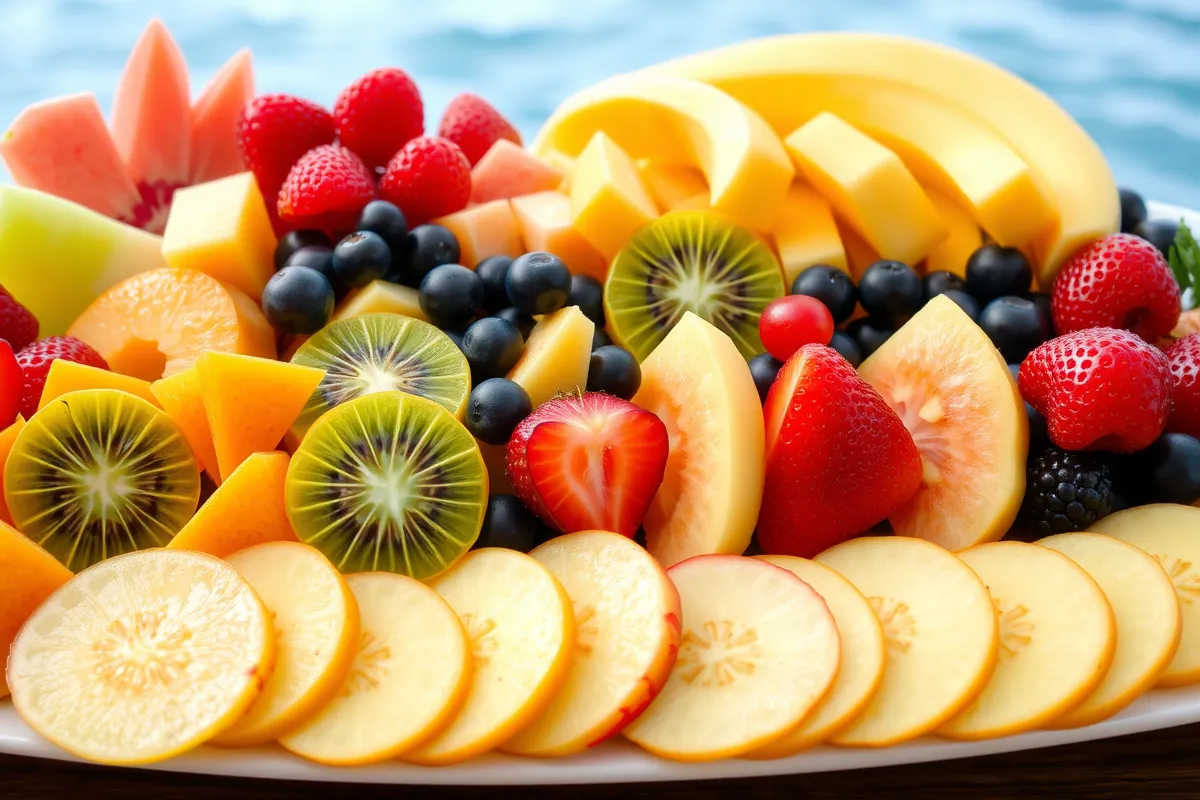A beautifully arranged fruit platter is more than just a healthy dessert or snack option; it’s a visually captivating centerpiece perfect for any gathering. Whether you’re hosting a brunch, a party, or just looking to elevate a simple family meal, a thoughtfully arranged fruit platter adds color, freshness, and flavor that appeals to everyone.
In this comprehensive guide, we will cover everything you need to know about creating an outstanding fruit platter, from selecting the right fruits to arranging them for maximum impact. We’ll also explore the many health benefits and provide answers to frequently asked questions about fruit platters.
Why Choose a Fruit Platter for Your Event?
There are many reasons why a fruit platter is a go-to choice for events of all types. From birthday celebrations to summer gatherings, fruit platters offer versatility, vibrant colors, and crowd-pleasing appeal. Unlike processed desserts, a well-curated fruit platter provides natural sweetness, loaded with nutrients and hydration.
Health Benefits: Fruits are an excellent source of vitamins, minerals, fiber, and antioxidants, making them an ideal addition to any diet. Including a variety of fruits on your platter ensures that your guests enjoy a nutrient-dense treat, which also supports immune health and hydration.
Visual Appeal: A fruit platter isn’t just a treat for your taste buds—it’s a feast for your eyes as well. Bright, colorful fruits naturally stimulate the appetite and add a festive flair to any table. Learn more about the psychological effects of color in food and why vibrant colors make food more enticing.
Easy Customization: The best part about creating a fruit platter is the ease of customization. With countless fruits available, you can personalize your platter to suit the season, your personal preferences, or even the event’s color theme. Here are some tips for eating seasonally, which will help you choose the freshest fruits at any time of year.
How to Choose the Right Fruits for Your Platter
The secret to crafting an amazing fruit platter lies in choosing a diverse selection of fruits that balance flavor, color, and texture. Below are some guidelines for selecting the perfect combination of fruits for your platter.
1. Balance of Colors
For an eye-catching fruit platter, focus on fruits of various colors. A rainbow assortment ensures visual interest and a wide range of nutrients. Fruit platters should ideally feature:
- Red Fruits: Strawberries, raspberries, cherries, watermelon.
- Orange Fruits: Cantaloupe, oranges, persimmons.
- Yellow Fruits: Pineapple, mango, bananas.
- Green Fruits: Grapes, kiwi, honeydew melon.
- Blue/Purple Fruits: Blueberries, blackberries, plums.
2. Texture and Flavor
Fruits vary in texture—some are crisp, others soft, and some juicy. Combining these different textures adds complexity to the experience. For example:
- Crispy Fruits: Apples, grapes.
- Soft and Juicy: Mango, kiwi, berries.
- Crunchy: Pineapple, pomegranate arils.
3. Seasonal Availability
To get the freshest and most flavorful fruits, select options that are in season. Seasonal fruits are often cheaper and tastier. For instance, berries are perfect for summer, while apples and pears make great additions in the fall.
4. Sweetness and Tartness
Balance is key in a fruit platter. If you include very sweet fruits like watermelon and grapes, balance them with something slightly tart, such as kiwi or green apples.
5. Fruits to Avoid
Some fruits don’t work well in a fruit platter because they discolor or spoil quickly. Here are some fruits to avoid:
- Bananas: They brown very quickly.
- Apples: Unless treated with lemon juice, they can oxidize and turn brown.
Step-by-Step Guide to Preparing Your Fruit Platter
1. Washing and Prepping the Fruits
Properly washing and preparing fruits is crucial, especially when serving raw. Use the following steps to ensure your fruit platter is clean and safe:
- Rinse Under Cold Water: Thoroughly rinse all fruits to remove pesticides and bacteria.
- Pat Dry: Use paper towels to pat each fruit dry. Excess water can make the fruit platter look soggy.
- Cut and Core: Remove seeds, cores, and any inedible parts. Slice larger fruits into bite-sized pieces for easy consumption.
2. Arranging the Fruit Platter
Arranging a fruit platter is both an art and a science. You want to make sure it’s as visually appealing as possible.
- Start with a Centerpiece: Place a fruit like pineapple or a bowl of dip at the center to act as a focal point.
- Layer Fruits by Color: Group similar colors together but place contrasting colors next to each other to make the colors pop.
- Use Garnishes: Mint leaves, edible flowers, and citrus wedges make great garnishes to elevate your platter’s presentation.
3. Using Serving Tools
Provide the appropriate serving tools to make your fruit platter accessible:
- Tongs: Helps guests pick individual pieces without touching others.
- Toothpicks or Skewers: For smaller fruits or fruit cubes, have toothpicks available.
Ideas for Unique Fruit Platter Themes
Creating a themed fruit platter can make it even more special for specific occasions. Below are some creative ideas:
1. Tropical Paradise Platter
- Fruits: Pineapple, mango, papaya, coconut, starfruit.
- Garnishes: Banana leaves, orchids.
- Occasion: Perfect for a summer beach party or tropical-themed event.
2. Berry-Licious Platter
- Fruits: Strawberries, blueberries, raspberries, blackberries.
- Dips: Whipped cream, Greek yogurt mixed with honey.
- Occasion: Ideal for brunch or baby showers.
3. Holiday Fruit Wreath
- Fruits: Green grapes, red grapes, kiwi, strawberries.
- Garnishes: Sprigs of rosemary to mimic pine needles.
- Occasion: Great for Christmas or winter gatherings.
4. Kid-Friendly Animal Shapes Platter

Create a fun and playful fruit platter that kids will love by cutting fruits into animal shapes:
- Fruits: Apples, kiwi, watermelon, berries.
- Tools: Use cookie cutters in the shape of animals like butterflies, turtles, and fish.
- Occasion: Perfect for children’s birthday parties or family picnics.
5. Monochromatic Platter
Choose fruits of a single color to create an elegant and striking monochromatic effect.
- Fruits: All yellow (pineapple, mango, yellow watermelon), all red (strawberries, raspberries, cherries), etc.
- Occasion: Classy gatherings such as bridal showers or themed events.
Enhancing Your Fruit Platter with Edible Decorations
1. Edible Flowers
Adding edible flowers to a fruit platter not only enhances the visual appeal but also adds subtle flavors that can complement the fruits. Some popular edible flowers include:
- Pansies: Light, fresh flavor.
- Marigolds: Slightly citrusy, adds a pop of orange color.
- Lavender: Pairs beautifully with berries for a more sophisticated touch.
Make sure that all flowers are organic and specifically labeled as edible to avoid any harmful pesticides or chemicals.
2. Fresh Herbs
Fresh herbs, like mint or basil, are an easy way to add a burst of color and an aromatic element to your fruit platter.
- Mint Leaves: Adds a refreshing note, perfect with watermelon, strawberries, and blueberries.
- Basil: Works well with tropical fruits like mango and pineapple, adding a hint of spice.
3. Citrus Zest
Sprinkle grated zest from lemons, limes, or oranges over the fruits for a vibrant flavor boost. Citrus zest provides a fragrant and slightly tart contrast that enhances the overall fruit flavors.
Tips for Keeping Your Fruit Platter Fresh
Fruit platters can start to lose their freshness quickly if not properly handled. Follow these tips to ensure your fruit platter looks great and tastes fresh throughout your event:
1. Keep it Cool
- Refrigerate Before Serving: Store your platter in the fridge until it’s ready to be served. Cold fruits are crispier, and refrigeration helps them stay fresh longer.
- Ice Bed: If you are serving the fruit platter outdoors, consider placing it on a bed of ice to keep it cool. Arrange the fruit platter on a larger tray filled with crushed ice to ensure the fruits stay chilled.
2. Add an Acidic Juice
Fruits like apples, bananas, and pears brown quickly after being cut. To prevent this, lightly brush or drizzle them with a mixture of lemon or lime juice. The acidity of the citrus helps slow down oxidation, keeping the fruits looking fresh.
3. Prepare Close to Serving Time
- Last-Minute Preparation: If possible, prepare your fruit platter as close to serving time as possible. This ensures the fruits are at their peak in terms of flavor, texture, and appearance.
- Cover with Plastic Wrap: If you need to prepare the platter in advance, cover it tightly with plastic wrap to prevent exposure to air.
Creating Fruit Skewers as Part of Your Platter
Fruit skewers are a fun way to add some dimension to your fruit platter, making it more interactive and easy to eat. Here are some tips for creating perfect fruit skewers:
1. Use Wooden or Bamboo Skewers
These are easy to handle, and you can find them in different sizes. Make sure to trim the sharp end for safety, especially if children are involved.
2. Mix Colors and Textures
Alternate between different colors and textures of fruits to make each skewer visually appealing and tasty. For example, you could mix:
- Strawberries, Pineapple, Kiwi: For a vibrant skewer with sweet and tart notes.
- Grapes, Melon, Blueberries: For a combination of crisp and juicy textures.
3. Add a Sweet Drizzle
After arranging the fruit on skewers, you can drizzle them with a little honey or melted chocolate for an added touch of sweetness. A light sprinkle of shredded coconut or chopped nuts adds extra flavor and crunch.
Creating Fruit Platter Dips
Adding a variety of dips can make your fruit platter even more delightful. Here are some ideas for creating delicious dips that complement the fruits:
1. Creamy Honey-Yogurt Dip
- Ingredients: 1 cup Greek yogurt, 2 tablespoons honey, 1 teaspoon vanilla extract.
- Method: Mix all the ingredients until smooth. This simple, creamy dip is lightly sweetened and pairs well with most fruits.
2. Chocolate Ganache Dip
- Ingredients: 1/2 cup heavy cream, 1/2 cup dark chocolate chips.
- Method: Heat the cream until warm, then pour over the chocolate chips. Stir until melted and smooth. This indulgent dip is perfect for strawberries, bananas, and apples.
3. Coconut Whipped Cream
- Ingredients: 1 can chilled coconut milk, 1 tablespoon powdered sugar.
- Method: Scoop out the coconut cream from the can and whip with sugar until light and fluffy. This dairy-free dip adds a tropical flair, especially when paired with pineapple or mango.
Fruit Platter for Different Dietary Needs

A fruit platter is versatile and can easily be adapted to accommodate different dietary requirements, making it a perfect choice for various guests.
1. Vegan Fruit Platter
All fruits are naturally vegan, so a fruit platter already fits into a plant-based diet. Make sure any dips are also vegan-friendly—for example, use coconut whipped cream or almond butter.
2. Low-Carb or Keto-Friendly Platter
If you have guests who follow a keto or low-carb diet, include low-carb fruits like berries (strawberries, blueberries, raspberries) and serve them with a high-fat dip like whipped cream or nut butter to increase satiety.
3. Allergy Considerations
Fruits are generally allergy-friendly, but it’s always wise to be aware of common allergies, such as to latex-related fruits (kiwi, bananas, avocados). Labeling your fruit platter or keeping potential allergens separate is a considerate touch.
Incorporating Fruit Platters into a Balanced Diet
Fruit platters can be a part of a balanced diet, providing essential vitamins, minerals, and fiber. Here are a few ways you can incorporate fruit platters into your daily meals:
1. Breakfast Boost
Add a fruit platter as a healthy side dish to your morning breakfast. Pair it with protein-rich foods like eggs, Greek yogurt, or a handful of nuts to create a balanced meal that keeps you energized throughout the morning.
2. Healthy Dessert
A fruit platter is a perfect alternative to sugar-laden desserts. When cravings for sweets strike, a mix of sweet, juicy fruits can provide the satisfaction you need without the added processed sugars. To make it extra special, serve with a drizzle of honey or a small portion of dark chocolate.
3. Post-Workout Recovery
After a workout, your body needs carbohydrates to replenish glycogen stores and protein to repair muscles. A fruit platter can be a great source of quick carbs to refuel your energy, especially when combined with a protein source like cottage cheese or a protein shake.
The Cultural Significance of Fruit Platters
Fruit platters have been an integral part of celebrations across various cultures for centuries. From weddings to religious ceremonies, the concept of presenting an array of fruits is symbolic of prosperity, abundance, and hospitality.
1. Mediterranean Tradition
In Mediterranean cultures, fruit platters are often served at the end of large family meals. They symbolize the value of fresh, seasonal produce and are seen as a healthy way to finish a meal. Common fruits include figs, grapes, pomegranates, and melons.
2. Chinese Celebrations
Fruit platters are significant in Chinese culture, often used in offerings during traditional festivals or important occasions. Fruits like oranges and apples symbolize prosperity, wealth, and peace. The fruit platter is seen as a gesture of hospitality when shared with guests.
3. Hawaiian Luaus
In Hawaiian culture, tropical fruits like pineapple, mango, and papaya are often arranged in stunning displays during luaus and festive gatherings. The vibrant colors and abundance of fresh, juicy fruits represent the tropical bounty of the islands and the spirit of Aloha.

